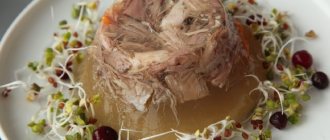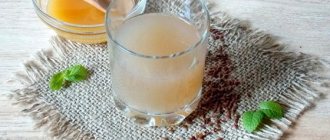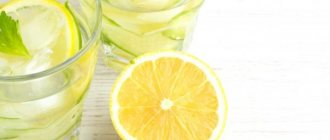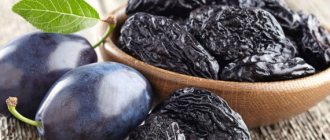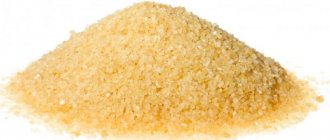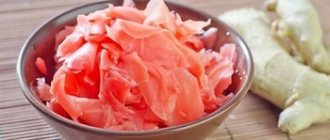What is jellied meat and how did it appear?
In essence, jellied meat is a transparent gelatinous jelly left after boiling a thick broth. The dish first appeared in the 14th century in France, where wealthy people could afford very rich meat soups. Initially, French chefs were skeptical about the taste of jelly, but over time, a dish called galantine was invented. To create it, processed meat was twisted into a jelly state, and then sent back to the broth and kept in the cold for some time.
Russian jellied meat appeared around the same time - although initially it was prepared from simple meat scraps. The tradition of seasoning jelly with spices and herbs arose later, and came precisely from Europe.
Chemical composition of jellied meat
Many people like the taste of jellied meat, but they value the product primarily for its beneficial properties. Namely, it contains:
- useful minerals - copper, potassium, phosphorus;
- elements fluorine, sulfur, rubidium;
- aluminum and boron, calcium and vanadium;
- polyunsaturated fatty acids;
- collagen and glycine;
- gelatin;
- retinol;
- valuable aliphatic amino acid;
- vitamins - C, B9, A.
Even a small portion of high-quality jelly brings great benefits to the body.
Benefits of jelly
Many people are interested in the question, what are the benefits of jelly? It should be noted that it contains a special protein – collagen. This substance is very beneficial for the body, especially for skin cells. It provides elasticity to tissues and prevents them from breaking down. Experts include this dish in the diet of those who have problems with the musculoskeletal system.
Jellied meat contains another useful substance – glycine. It has a beneficial effect on human performance, increases concentration, and also improves memory. Consequently, jelly has a lot of beneficial properties and vitamins.
How many calories are in jellied meat
Since jellied meat is made from different types of meat, the calorie content may vary.
- Pork jelly is the most nutritious - calorie content ranges from 340 to 390 calories per 100 g of product.
- In second place is beef jellied meat - it contains from 130 to 180 calories.
- The least calorie-rich jellied meat is made from lean poultry meat - turkey or chicken. It contains from 80 to 200 calories.
Pork jellied meat is recommended to be consumed only by very healthy people - for many ailments, a fatty dish will be harmful. The properties of jellies made from poultry and beef are considered the most dietary.
More on the same topic:
10 comments
- Stella Writes, Well, what is the calorie content of chicken jellied meat? There is a recipe, but it’s not clear what the calorie content is.
- Lerka Writes,
If you go by the recipe given, then the calorie content of such jellied meat should be somewhere in the region of 100 kilocalories per 100 grams, maybe a little more. - Kopylova writes,
Actually, jellied meat is a delicate matter, and the calorie content of jellied meat, as well as the signature recipe, will be different for each housewife. - Marya writes,
The lowest calorie content of beef jellied meat, which, by the way, can be further reduced if you put beef tongue in the beef broth. And much tastier. - Roza Writes,
!80 kilocalories? Not so much! There's a lot more to chocolate and confectionery! - Marya writes,
But there is less fat in the confectionery. - Daria Writes,
and what kind of recipe is this? This is not jellied meat - this is jelly. Who adds gelatin in the cold? - ZoyaK Writes,
Added. And they call it jellied meat. What to do if the infection does not freeze? - Irma writes,
Gelatin is not added. Need to cook more!!!!!! - Alusik Writes,
Good afternoon! I don’t understand how jellied meat can’t harden??? especially if it’s made from beef, you just need to cook it for about six hours, that’s all. I don’t even know what gelatin is
What are the health benefits of jellied meat?
Meat jelly is not only nutritious, it has a pleasant taste and is beneficial for the body. Specific valuable properties depend on what meat the dish is prepared from. But there are several common qualities inherent in any jelly. Namely, the product has a positive effect:
- for immunity - retinol present in the dish successfully fights viruses and infections;
- on joints - gelatin in the product strengthens bone and connective tissue;
- on the nervous system - glycine in the jelly improves brain function and helps get rid of depression;
- on metabolic processes - in particular, the product’s properties are very effective for hangover syndrome.
What didn't we know about aspic?
Jellied meat rarely appears on our tables as an everyday dish, since it needs to be boiled for several hours, then poured into molds and waited until it hardens. Therefore, jelly is one of the main decorations of the festive table. Despite the relatively high nutritional value, this treat is fraught with great benefits. This is primarily due to the collagen content.
This component is necessary for our nail plates, skin, bone tissue, and joints. Elasticity increases, metabolic processes are stabilized. People who eat jellied meat can prevent the development of the process of premature aging of the body.
Gelatin helps improve the condition of joint tissue and maintain their shock absorption. The aminoacetic acid contained in the jelly should not be ignored. It helps to activate the functioning of the brain and also helps get rid of depression.
And an important component is meat. Regardless of the variety, this product is primarily regarded as a source of protein. In addition, meat contains vitamins from group B, which makes it possible to compensate for their deficiency in the body and improve overall health.
On a note! If you want to include jellied meat in your diet without harming your figure, pay attention to dishes made from turkey, chicken or beef. But it’s better to abstain from jellied pork.
By the way, there is also a flip side to the coin - a large amount of cholesterol in fatty meats. If this indicator increases, this can cause the development of atherosclerosis. Therefore, you also need to take into account the possible negative consequences of eating jellied meat.
Jellied meat for treating joints
Among the beneficial properties of the product, one valuable quality is especially noted - a positive effect on joints and connective tissues. The fact is that any jelly, especially beef, contains a high percentage of animal protein. It is protein that is largely responsible for the rapid restoration of tendons, cartilage, ligaments and bones.
Regular consumption of beef or pork jelly is highly recommended for athletes. During training, their joints are subjected to particularly heavy loads and are often injured. The protein, collagen and carotene in the product can protect bone tissue from destruction, and in addition, will further increase physical endurance.
The benefits of pork jellied meat
The beneficial properties of a product made from pork knuckle, tail, ears or legs are dictated by the valuable qualities of the pork itself. In particular, it contains amino acids and iron, vitamin B12 and myoglobin, animal fat.
Pork jellied meat:
- effectively protects the body from vitamin deficiency;
- replenishes calcium reserves;
- has a beneficial effect on the condition of blood vessels and the heart.
Attention! The benefit of jellied pork legs for men is that the properties of the product serve as a prevention of prostatitis and improve potency.
The benefits of beef jellied meat
Jelly made from beef is less fatty than pork and is much better digestible, by as much as 76%. Therefore, you can use the product even with many gastrointestinal diseases; it will not cause harm.
Beef jelly contains a large amount of vitamin A, so it is extremely beneficial for eye health. The product contains carotene, which strengthens muscle, bone and connective tissues and promotes their recovery. The benefits of jellied beef legs will be especially great for athletes whose muscles and joints are subject to special stress.
What are the benefits of chicken jellied meat?
A product made from chicken or turkey meat is most useful for those who want to lose weight. The calorie content of jelly is very low, and it contains a lot of valuable substances. These are the main vitamins C, A, B, elements: iron and magnesium, calcium.
Choline in chicken or turkey jellied meat helps regulate metabolism and has a beneficial effect on the nervous system. The collagen present in the product has a good effect on hair and skin. This is also why the benefits of jellied chicken feet will be especially great for the fair sex.
Can jellied meat be used by pregnant and lactating women?
During the period of bearing a child, jelly can bring both benefit and harm. The main danger is that the product can increase cholesterol levels in the blood and cause excess weight gain.
However, the product also has benefits for pregnant women. Jellied meat improves hemoglobin production, helps absorb calcium, removes toxins and strengthens the immune system. Therefore, you can still take the product during pregnancy - just in small quantities, and after consulting a doctor.
Jellied meat is also approved for use during breastfeeding. It does not have a negative effect on the baby's health. But the product should be consumed without seasonings and herbs, in order to avoid allergies and colic in the baby.
Energy value of pork jellied meat
Jelly made from pork has the highest calorie content. This is due, first of all, to the fact that pigs are raised not only to produce meat, but also lard.
Thus, per 100 grams of product the data ranges from 190 to almost 330 kilocalories.
An important role in this case is played by the fat content of the ingredient of the dish chosen for cooking. Consequently, due to the fact that the calorie content of jellied meat is quite high, it cannot be consumed during fasting days or during a diet.
At what age can jellied meat be given to children?
Classic jelly is too “heavy” food for a child’s body. But the beneficial properties of the product are still important for growing babies. Therefore, children from 6 or 7 months of age are recommended to be offered a special homemade baby jellied meat - made from chicken meat, without salt and other seasonings and spices. The benefit of chicken aspic will be that the product will strengthen the child’s immunity and promote the development of bones and muscles.
You should start complementary feeding using an amount of no more than a quarter of a teaspoon. If there is no negative reaction, then gradually, by the time the child is one year old, the amount of jelly can be increased to 50 g per day.
Important! Since even low-fat and unsalted jellied meat can harm a child, it can be introduced into the diet only after consultation with a pediatrician.
How to cook jellied meat at home
You don’t have to buy classic jelly in a store—you can make the delicacy yourself at home. Since the benefits of jellied beef are the greatest, and the harm is minimal, it is recommended to cook it. You will need to take the following products:
- cleaned beef leg, or fetlock joint - 1.3 kg;
- beef of the highest category - 800 g;
- chicken breast - 1.8 kg;
- water - 3 l;
- carrots - 300 g;
- onions - 350 g;
- a little garlic - about 40 g;
- parsley root - 250 g.
The dish takes a long time to prepare, but without any particular difficulties.
- The beef leg is chopped and poured with 2-3 liters of water, and then boiled for 8 hours over low heat, not forgetting to skim off the foam.
- About 4 hours after the start of cooking, chicken and beef are added to the fetlock joint.
- After 7.5 hours, add vegetables to the pan.
When the components of the future jelly are cooked, the meat is cooled to a warm temperature, chopped into small pieces or passed through a meat grinder, after removing all the veins and bones. The resulting minced meat is again placed in the strained broth, salted, cooked for another 20 minutes, then garlic is added.
The finished jelly is distributed into molds and left for several hours in the refrigerator so that the jelly hardens properly.
Calorie content Homemade jellied meat. Chemical composition and nutritional value.
Nutritional value and chemical composition of “Homemade Aspic”.
The table shows the nutritional content (calories, proteins, fats, carbohydrates, vitamins and minerals) per 100 grams of edible portion.
| Nutrient | Quantity | Norm** | % of the norm in 100 g | % of the norm in 100 kcal | 100% normal |
| Calorie content | 60 kcal | 1684 kcal | 3.6% | 6% | 2807 g |
| Squirrels | 6 g | 76 g | 7.9% | 13.2% | 1267 g |
| Fats | 4 g | 56 g | 7.1% | 11.8% | 1400 g |
| Carbohydrates | 0.6 g | 219 g | 0.3% | 0.5% | 36500 g |
| Alimentary fiber | 0.1 g | 20 g | 0.5% | 0.8% | 20000 g |
| Water | 88 g | 2273 g | 3.9% | 6.5% | 2583 g |
| Ash | 1.12 g | ~ | |||
| Vitamins | |||||
| Vitamin A, RE | 2.5 mcg | 900 mcg | 0.3% | 0.5% | 36000 g |
| alpha carotene | 0.14 mcg | ~ | |||
| beta carotene | 0.026 mg | 5 mg | 0.5% | 0.8% | 19231 g |
| beta Cryptoxanthin | 7.046 mcg | ~ | |||
| Lycopene | 0.003 µg | ~ | |||
| Lutein + Zeaxanthin | 18.39 mcg | ~ | |||
| Vitamin B1, thiamine | 0.086 mg | 1.5 mg | 5.7% | 9.5% | 1744 g |
| Vitamin B2, riboflavin | 0.035 mg | 1.8 mg | 1.9% | 3.2% | 5143 g |
| Vitamin B4, choline | 15.63 mg | 500 mg | 3.1% | 5.2% | 3199 g |
| Vitamin B5, pantothenic | 0.12 mg | 5 mg | 2.4% | 4% | 4167 g |
| Vitamin B6, pyridoxine | 0.078 mg | 2 mg | 3.9% | 6.5% | 2564 g |
| Vitamin B9, folates | 0.996 mcg | 400 mcg | 0.2% | 0.3% | 40161 g |
| Vitamin B12, cobalamin | 0.488 mcg | 3 mcg | 16.3% | 27.2% | 615 g |
| Vitamin C, ascorbic acid | 0.27 mg | 90 mg | 0.3% | 0.5% | 33333 g |
| Vitamin E, alpha tocopherol, TE | 0.142 mg | 15 mg | 0.9% | 1.5% | 10563 g |
| gamma tocopherol | 0.061 mg | ~ | |||
| delta tocopherol | 0.002 mg | ~ | |||
| Vitamin H, biotin | 1.001 mcg | 50 mcg | 2% | 3.3% | 4995 g |
| Vitamin K, phylloquinone | 0.5 mcg | 120 mcg | 0.4% | 0.7% | 24000 g |
| Vitamin RR, NE | 1.3015 mg | 20 mg | 6.5% | 10.8% | 1537 g |
| Niacin | 1.009 mg | ~ | |||
| Betaine | 0.011 mg | ~ | |||
| Macronutrients | |||||
| Potassium, K | 63.67 mg | 2500 mg | 2.5% | 4.2% | 3926 g |
| Calcium, Ca | 21.97 mg | 1000 mg | 2.2% | 3.7% | 4552 g |
| Silicon, Si | 0.007 mg | 30 mg | 428571 g | ||
| Magnesium, Mg | 9.32 mg | 400 mg | 2.3% | 3.8% | 4292 g |
| Sodium, Na | 361.61 mg | 1300 mg | 27.8% | 46.3% | 360 g |
| Sera, S | 64.36 mg | 1000 mg | 6.4% | 10.7% | 1554 g |
| Phosphorus, P | 47.5 mg | 800 mg | 5.9% | 9.8% | 1684 g |
| Chlorine, Cl | 530.92 mg | 2300 mg | 23.1% | 38.5% | 433 g |
| Microelements | |||||
| Aluminium, Al | 1.2 mcg | ~ | |||
| Bor, B | 0.1 mcg | ~ | |||
| Vanadium, V | 0.01 mcg | ~ | |||
| Iron, Fe | 0.596 mg | 18 mg | 3.3% | 5.5% | 3020 g |
| Yod, I | 1.07 mcg | 150 mcg | 0.7% | 1.2% | 14019 g |
| Cobalt, Co | 1.917 mcg | 10 mcg | 19.2% | 32% | 522 g |
| Lithium, Li | 0.008 mcg | ~ | |||
| Manganese, Mn | 0.029 mg | 2 mg | 1.5% | 2.5% | 6897 g |
| Copper, Cu | 68.71 mcg | 1000 mcg | 6.9% | 11.5% | 1455 g |
| Molybdenum, Mo | 4.253 mcg | 70 mcg | 6.1% | 10.2% | 1646 g |
| Nickel, Ni | 1.832 mcg | ~ | |||
| Tin, Sn | 8.1 mcg | ~ | |||
| Rubidium, Rb | 0.2 mcg | ~ | |||
| Selenium, Se | 0.774 mcg | 55 mcg | 1.4% | 2.3% | 7106 g |
| Fluorine, F | 83.9 mcg | 4000 mcg | 2.1% | 3.5% | 4768 g |
| Chromium, Cr | 1.98 mcg | 50 mcg | 4% | 6.7% | 2525 g |
| Zinc, Zn | 0.7102 mg | 12 mg | 5.9% | 9.8% | 1690 g |
| Digestible carbohydrates | |||||
| Starch and dextrins | 0.118 g | ~ | |||
| Mono- and disaccharides (sugars) | 0.2 g | max 100 g | |||
| Galactose | 0.001 g | ~ | |||
| Glucose (dextrose) | 0.009 g | ~ | |||
| Sucrose | 0.011 g | ~ | |||
| Fructose | 0.002 g | ~ | |||
| Essential amino acids | |||||
| Arginine* | 0.262 g | ~ | |||
| Valin | 0.183 g | ~ | |||
| Histidine* | 0.123 g | ~ | |||
| Isoleucine | 0.135 g | ~ | |||
| Leucine | 0.26 g | ~ | |||
| Lysine | 0.297 g | ~ | |||
| Methionine | 0.069 g | ~ | |||
| Methionine + Cysteine | 0.104 g | ~ | |||
| Threonine | 0.14 g | ~ | |||
| Tryptophan | 0.031 g | ~ | |||
| Phenylalanine | 0.144 g | ~ | |||
| Phenylalanine+Tyrosine | 0.24 g | ~ | |||
| Nonessential amino acids | |||||
| Alanin | 0.263 g | ~ | |||
| Aspartic acid | 0.33 g | ~ | |||
| Hydroxyproline | 0.042 g | ~ | |||
| Glycine | 0.436 g | ~ | |||
| Glutamic acid | 0.602 g | ~ | |||
| Proline | 0.322 g | ~ | |||
| Serin | 0.155 g | ~ | |||
| Tyrosine | 0.103 g | ~ | |||
| Cysteine | 0.04 g | ~ | |||
| Sterols (sterols) | |||||
| Cholesterol | 8.73 mg | max 300 mg | |||
| Phytosterols | 0.561 mg | ~ | |||
| Saturated fatty acids | |||||
| Saturated fatty acids | 0.8 g | max 18.7 g | |||
| 14:0 Miristinovaya | 0.08 g | ~ | |||
| 15:0 Pentadecane | 0.015 g | ~ | |||
| 16:0 Palmitinaya | 0.616 g | ~ | |||
| 17:0 Margarine | 0.038 g | ~ | |||
| 18:0 Stearic | 0.299 g | ~ | |||
| 20:0 Arakhinovaya | 0.001 g | ~ | |||
| 22:0 Begenovaya | 0.001 g | ~ | |||
| Monounsaturated fatty acids | 0.886 g | min 16.8 g | 5.3% | 8.8% | |
| 14:1 Myristoleic | 0.036 g | ~ | |||
| 16:1 Palmitoleic | 0.133 g | ~ | |||
| 18:1 Oleic (omega-9) | 0.946 g | ~ | |||
| 20:1 Gadoleic (omega-9) | 0.012 g | ~ | |||
| 22:1 Erucic (omega-9) | 0.027 g | ~ | |||
| 24:1 Nervonic, cis (omega-9) | 0.002 g | ~ | |||
| Polyunsaturated fatty acids | 0.102 g | from 11.2 to 20.6 g | 0.9% | 1.5% | |
| 18:2 Linolevaya | 0.086 g | ~ | |||
| 18:3 Linolenic | 0.032 g | ~ | |||
| 20:2 Eicosadiene, Omega-6, cis, cis | 0.001 g | ~ | |||
| 20:4 Arachidonic | 0.003 g | ~ | |||
| Omega-6 fatty acids | 0.1 g | from 4.7 to 16.8 g | 2.1% | 3.5% |
The energy value of Homemade Aspic is 60 kcal.
Primary Source: Created in the application by the user. Read more.
** This table shows the average levels of vitamins and minerals for an adult. If you want to know the norms taking into account your gender, age and other factors, then use the “My Healthy Diet” application.
Harm of jellied meat and contraindications
No matter how great the benefits of a product, sometimes it can cause harm. The main risks are related to the fact that:
- fatty thick jellied meat contains quite a lot of cholesterol, so it can negatively affect blood vessels, liver and heart;
- the product contains growth hormone - it is harmful in large quantities or in the presence of allergies;
- Pork jelly contains a substance called histamine, which is harmful to people with impaired bile production;
- Jelly is high in calories and can contribute to weight gain if consumed indefinitely.
Thus, we can identify a list of diseases and conditions for which jellied meat is contraindicated. Namely, its properties will cause harm:
- with a tendency to obesity;
- if there is an individual intolerance to any components;
- for diseases of the gallbladder;
- for gout;
- for severe vascular and heart diseases;
- in case of intestinal dysfunction, jellied meat, especially pork, is difficult to digest.
We recommend reading: Benefits of bell pepper, properties
Advice! If you have a sensitive stomach, you should not use a product with hot spices: pepper, ginger, garlic.
We recommend reading: Chili peppers: benefits and harms, properties, how to eat them
Nutritionists recommend enjoying the product no more than 2 times a week in small portions. Then the health benefits and harms of jellied meat will be balanced.
The benefits and harms of jellied meat - how is jellied meat useful?
Who can eat jellied meat harm?
- If you are on a diet, eat jellied meat sparingly due to its high calorie content.
- Jellied meat, in addition to useful substances, is a source of harmful cholesterol (imagine how much of this substance a rich meat broth contains - especially pork!). It is known that cholesterol is the culprit of vascular and heart diseases; it can cause the formation of blood clots and plaques on the walls of blood vessels.
- Meat broths are rich in growth hormone. This hormone is the main culprit in the occurrence of inflammatory processes in our body. This hormone can also lead to tissue swelling and hypertrophy (painful enlargement of cells and tissues).
- Jellied pork contains an organic compound, hista, which can cause gallbladder disease, appendicitis and furunculosis.
- Do not overdo it with spices (garlic, mustard, pepper, onion, horseradish, ginger) - if eaten in large quantities, they will hit the stomach and liver.
Everything has its pros and cons, jellied meat will not be an exception in this case.
Jellied meat is one of the favorite delicacies of our ancestors. It is as tasty as it is dangerous due to its calorie content. On average, 100 grams contain 250-350 calories, which is not entirely good for humans.
Jellied meat contains cholesterol, which in large quantities has a detrimental effect on humans and contributes to the appearance of problems with blood vessels.
This meat dish contains growth hormone, which, when entering the body, causes tissue inflammation, which causes more dangerous diseases to grow.
If you prepare this dish correctly, you can avoid many problems. For example, if you boil meat instead of frying it, you can avoid problems with cholesterol. If you make jellied meat in pork broth, the risk of exacerbation of appendicitis increases, and the pig meat itself is very difficult to digest, which causes discomfort to the stomach.
With the right attitude towards the dish, you can get an absolutely pure, healthy product for the body, which will only bring benefits. Use proven recipes.
Initially, this dish, back in Rus', was intended for feeding servants as it was prepared from leftover meat from tables after festivities, mixed until it became a thick porridge, boiled a little with the addition of broth and sent to the cold. The appearance and taste, of course, left much to be desired.
But today, the recipe and ingredients used have made jellied meat a welcome guest at various holidays and a delicious dish.
It is believed that it was the French who were the first to prepare jellied meat. They cooked a rich broth from cartilage and bones, which became thick and viscous when cooled.
The chefs at court gave this not very appetizing dish a sophistication: they first boiled freshly killed game, then twisted the meat, added broth, eggs and spices to it. Afterwards the dish was placed in the cold.
The French gave it the name “galantine” (translated as “jelly”).
In Russia there was a similar dish called “studen”. They prepared it for the common people from scraps from the master's table in order to save on food. When the ball and feast ended, the leftover meat dishes were mixed into porridge and boiled in broth, after which they were left in the cold.
Thanks to the reigning fashion for “everything French” in the 16th century, chefs from France began to appear in Russia, who “ennobled” the jelly, using the recipe of their galantine, they made it transparent and refined, adding lemon zest, turmeric and saffron to brighten it.
At various holidays this dish takes its place of honor. Housewives try to make it tasty, appetizing and unusual in appearance.
However, in addition to taste, jellied meat has some beneficial properties that can provide our body with an invaluable service. So, in addition to enjoying the taste and appearance, this dish can make us healthier:
- this wonderful dish contains a lot of vitamins (the main ones include VitaC, A and B9), and is also a rich source of trace elements: calcium, rubidium, sulfur, alium, fluorine, phosphorus, vanadium and boron. The most interesting thing is that, although it takes a lot of time to cook the broth for jellied meat, long-term heat treatment does not destroy the beneficial substances in it;
- jellied meat contains polyunsaturated fatty acids, which have a positive effect on the nervous system;
- An acid such as glycine activates brain cells, removes irritation, reduces fatigue and helps get rid of long-term depression. The most interesting thing is that glycine contains acetic acid, which can save you from a hangover. Therefore, the morning after the holiday, people who combined drinking alcohol with eating jellied meat suffered less from a hangover!
- This dish contains the acid lysine. This substance is an active participant in the process of calcium absorption, as well as a virus fighter;
- vitamin B is extremely important for the formation of hemoglobin;
- Probably one of the most important beneficial components of jellied meat is collagen, which, although it is destroyed during the cooking process, in the end there is still enough of it to make this dish valuable for our body. After all, collagen is the basis for our connective tissue (cartilage, bones, tendons are built from it), it is a building protein necessary for every cell in general, it is collagen that can reduce the abrasion of cartilage tissue and bones, and also slow down the aging process of the body, making our skin resilient and elastic. By the way, there is a claim that collagen from beef jellied meat is absorbed worse than from pork. And one more thing: there is an opinion that eating jellied meat in reasonable quantities during pregnancy will help a woman protect herself from stretch marks;
- The gelatin in this dish improves the condition of the joints. However, it is important to remember that the broth should not be overcooked, since the protein is quickly destroyed during prolonged boiling.
With so many beneficial properties, jellied meat has a significant drawback: this hearty dish is quite high in calories. Judge for yourself:
- calorie content of pork jellied meat (depending on what part you cook it from) - 180-350 kcal per 100 g of dish;
- calorie content of beef jellied meat – 80-140 kcal;
- calorie content of chicken - 120 kcal;
- calorie content of turkey - 52 kcal.
Harm from jellied meat
However, French chefs were smart and changed the recipe. Any game, pork, or beef was first boiled until tender, then the meat was twisted several times to obtain a homogeneous viscous consistency. After that, they mixed it with the strained broth, added spices and kept it in the cold so that the mass hardened. This meat dish became known as “galantine”.
The Russian people invented their own version of “galantine”, which was called “jelly”. All uneaten meat delicacies after the lordly feasts were sent to a large cauldron, where they turned into one continuous porridge-like mass. It was then left in a cool place to harden. Of course, such “secondary” food was no longer served to the gentlemen. It was intended only for servants in order to save money.
During its development in the 16th century, Russia was greatly influenced by fashion trends in France. People of the upper class, wealthy ladies and gentlemen could afford to hire not only a whole staff of tailors, governesses, maids, but also the best cooks.
Over time, French chefs began serving an updated jellied meat recipe at gourmet dinners. They learned to add lightening ingredients to the broth, for example, turmeric, saffron or lemon zest.
The taste and aroma of the dish improved significantly, which gave rise to including “aspic” in the list of indispensable cold appetizers in rich homes.
Gradually jellied meat became popular. Nowadays, pork, beef, and chicken are added to jellied meat as the main ingredients.
boiled potatoes - benefits and harms
This cold dish contains an impressive amount of healthy nutrients. Microelements are represented by alu, fluorine, boron, rubidium, vanadium. Macroelements are calcium, phosphorus and sulfur. Despite the rather long cooking of the broth, all the beneficial substances are preserved. Among the vitals, vitaC, A, B9 are distinguished.
- Positive effect on the nervous system due to the presence of polyunsaturated fatty acids.
- The body's immune function improves and calcium absorption increases.
- VitaB9, which is part of the composition, increases the level of hemoglobin in the blood.
- Brain cells begin to actively interact under the influence of lycine. The general physical condition of the body improves.
- The aging process of skin cells is slowed down due to the presence of collagen in aspic. It becomes elastic and elastic. The functioning of the musculoskeletal system also improves noticeably.
- The effect of gelatin has a beneficial effect on the functioning of joints.
Calorie content of the dish
Considering the fact that jellied meat is a frequent guest on the holiday table, you need to know how high-calorie such an appetizer is. This indicator is quite high, because per 100 grams. The product contains 250 kcal.
The higher the fat content of the meat on which the broth is prepared, the correspondingly higher the calorie content of the jellied meat. For lovers of low-fat, light food, beef bones are perfect for making jellied meat.
You should not often use the services of supermarkets and buy culinary dishes there. Jellied meat is easy to prepare with your own hands, then you can be sure that the dish will not only be the most delicious, but also healthy.
pork fat - benefits and harms
Pork jellied meat
Pork jellied meat contains vitamin B12, zinc, iron and various acids, which are rich in red meat.
These components are excellent helpers in the fight against avitaz, low levels of iron and calcium in the body. Pork also contains large amounts of myoglobin, which speeds up the movement of oxygen in the muscles.
This property of myoglobin can significantly reduce the risk of cardiovascular diseases.
Eating pork meat prevents the development of any male diseases, such as prostatitis or infectious diseases, including preventing premature impotence. Pork fat and lard included in jellied meat not only satiate the body, but also charge it with positive energy and improve physical condition.

